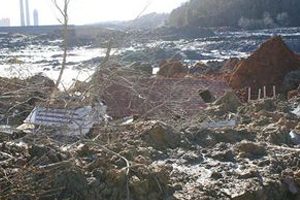
Another Accident Dumped Coal Ash Into Potomac River In Maryland. We have long been reporting on the catastrophic Tennessee Valley Authority (TVA) fly ash spill that took place this past December and spilled 5.4 millions cubic yards of fly ash, decimating the environment in that state. Now, another accident has dumped 4,000 gallons of coal ash […]

Another Accident Dumped Coal Ash Into Potomac River In Maryland. We have long been reporting on the catastrophic Tennessee Valley Authority (TVA) fly ash spill that took place this past December and spilled 5.4 millions cubic yards of fly ash, decimating the environment in that state. Now, another accident has dumped 4,000 gallons of coal ash sludge into the Potomac River in Maryland this weekend.
Nashville Scene reported that a pipeline ruptured on Sunday at a coal-burning power plant, which contaminated the West Virginia banks of the Potomac. The hole that caused the spill that began on Sunday evening and continued until Monday morning was reported to be about the size of a dime, but continuously spilled the slurry until a routine inspection by employees turned up the slurry accident.
We have also been reporting on the environmental dangers resulting from the devastating TVA fly ash spill that is exposing area Tennessee residents and the environment to some serious and dangerous health and environmental problems, such as radium and arsenic exposure.
Radium—a Group-A carcinogenic material according to the Environmental Protection Agency (EPA)—exposure can lead to cancer. Arsenic, a dangerously toxic metal, can increase the risk of some cancers, skin damage, and circulatory problems.
Dredging the coal sludge in Tennessee could release dangerous amounts of selenium in the area waterways, said the Tennessean in an earlier report. Selenium, while necessary to humans and animals, could result in catastrophic outcomes on fish when released at high levels, according to scientists, noted the Tennessean, when the dredging often needed to clean such spills releases toxic levels of the mineral into the water.
Similar effects could be expected in Maryland based on the known dangers from ash sludge. Now, the EPA is considering storage pond regulation and many hope the government will see the issue of coal ash as a hazard not limited to Tennessee, but one that originates with coal and coal-burning plants, the Nashville Scene noted.
The Associated Press reported that, according to a spokesman for the Maryland Department of the Environment, the spill occurred where New Page Corporation—a papermaker—maintains an ash storage lagoon; New Page also operates a coal-burning power plant to produce the electricity needed to run the paper mill.
Fly ash is a residue that results from coal combustion and is one of two ashes that, combined, are called coal ash. This waste product can contain—depending on the coal from which it originated—toxins such as arsenic, beryllium, boron, cadmium, chromium, chromium VI, cobalt, dioxins, lead, manganese, mercury, molybdenum, PAH compounds, elenium, strontium, thallium, and vanadium.
According to the Cumberland Times News, the Maryland sludge contained high concentrations of selenium, sulfate, arsenic, iron, and manganese.
The damaged Maryland pipeline was shut down; two other lines continue to operate, carrying ash slurry from the power plant to an ash storage lagoon about 800 feet away in West Virginia.
“Obviously, fly ash is not something that one wants in the water,” Harley Speir, a fisheries biologist with the state Department of Natural Resources, told the Cumberland Times News. The mill is planning on conducting a thorough inspection of the pipelines and also plans on enhancing its preventative maintenance program.
The personal injury attorneys at Parker Waichman LLP offer free, no-obligation case evaluations. For more information, fill out our online contact form or call 1-800-YOURLAWYER (1-800-968-7529).
Our Fly ash spill attorney is here to help you when you need it the most.


